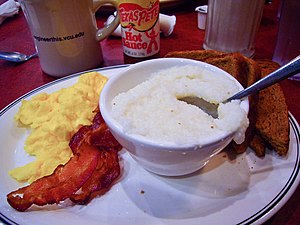
Grits are small broken grains of corn. They were first produced by Native Americans centuries ago. They're are made from corn grits and "hominy" grits.
Grits is a food of Native American origin that is common in the Southern United States, mainly used in breakfast. It consists of coarsely ground corn. Grits is also similar to other thick maize-based porridges from around the world, such as polenta. It also resembles farina, a thinner porridge. Grits can also be fried in a pan or molded to create a firm block. The resulting block can be cut with a knife or wire, and the slices are fried in a fat such as vegetable oil, butter, or bacon grease.

Hominy grits, or just plain grits, are an institution in the South. Hominy is made from flint or dent corn,varieties with hard kernels that are dried on the cob then removed and soaked in a solution of baking soda, lime, or wood ash. This process causes the hulls to soften and swell. The kernels are then hulled and degermed using friction, then dried. Grits, coarse whitish grains, are ground from hominy, as is masa harina, the flour used to make corn tortillas. It's interesting that the alkaline soaking process used to soften the corn also unbinds necessary niacin in the corn, and has an effect on the protein balance. Though the overall available protein is decreased, the relative availability of the lysine and tryptophan are increased. The alkaline process has been used for centuries where corn was a native food, but in areas where corn was introduced as a new staple, the process was not. Pellagra, a niacin and tryptophan deficiency, became common disease in areas where corn was the main source of food, as in the early South. One has to wonder how ancient civilizations discovered the process which made corn a more balanced source of nutrition. The word grits comes from the Old English. "grytt", for "bran", but the Old English "greot" also meant something ground. Some cookbooks refer to grits as hominy because of regional preference for the name. Americans have been using the term "grits" since at least the end of the 18th century.
Regular corn grits are made from white hybrid corn is dried to a 14% moisture content, then each kernel is cleaned with forced air. The kernels of grain are run through the mill stone where they are ground to a certain texture and then sifted through two wire mesh screens. The three products sorted are white corn meal, white corn grits and the bran that pops off. There is a fine bran still in the grits product. This bran will never soften up with cooking. Depending on personal preference, the bran can be left in or removed by rinsing the grits before cooking. Now hominy grits are made from field corn that is soaked in lye water (potash water in the old days) and stirred over the next day or two until the entire shell or bran comes loose and rises to the top. The kernel itself swells to twice its original size. After the remaining kernels have been rinsed several times, they are spread to dry either on cloth or screen dryers. Yellow grits include the whole kernel, while white grits use hulled kernels.
Grits are prepared by simply boiling the ground kernels into a porridge until enough water vaporizes to leave it semi-solid. Many communities in the U.S. used a gristmill up until the mid-20th century, with families bringing their own corn to be ground, and the miller retaining a portion of the corn for his fee. In South Carolina, state law requires grits and corn meal to be enriched, similar to the requirements for flour, unless the grits are ground from corn from which the miller keeps part of the product for his fee.
Now, listen up if you're looking to make serious changes to your body, then grits are probably not the best choice for carbohydrates to go with your breakfast. One 1-cup serving contains about 37 grams of carbs, 4 grams of protein, and almost a gram of fat. Compare this to a 1-cup serving of oatmeal, which contains only 13.5 grams of carbs, 2.1 grams of protein, 2.2 grams of fiber, and only .5 grams of fat.
I'm a big believer in moderation. So, during the week, I follow a pretty strict diet, and on the weekend, I relax a little bit and eat what I want. If you crave something different at breakfast, have some grits on the weekend.(with some bacon! yea I said it !) yummmmm ! Enjoy life you only live once... Good Luck...
No comments:
Post a Comment